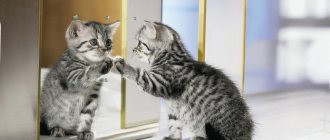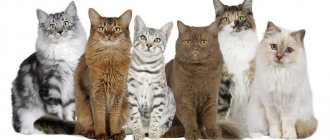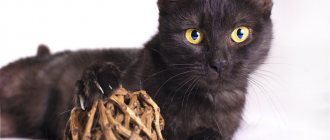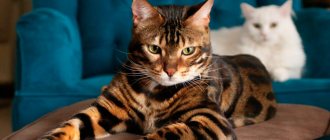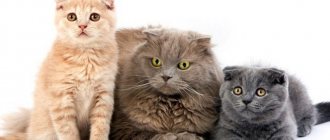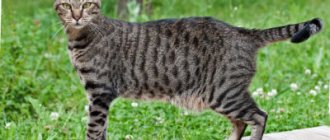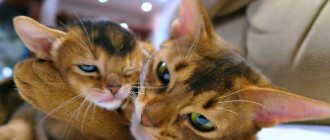Javanese
Javanese (in English - javanese) is the second name of the breed. The sound of the word resembles the name of the island of Java. It is from the island name that the name of the breed comes, although it has nothing to do with the history of breeding.
It is believed that the Javanese originated from the Siamese cat; the breed was obtained as a result of selection experiments on breeding the Balinese cat. Due to the successful external characteristics of the resulting species, it was decided to breed it as an independent breed.
The Javanese cat differs from the Balinese in coat color and eye color. There is a species with a “colorpoint” color, which often has blue eyes, and there is a solid color with green eyes. Quite soon after the breeding, the Javanese was recognized as an independent breed and a standard was developed based on the phenotype of cats.
Types of wool
You can understand what breed a domestic kitten or an adult cat belongs to by the length and structure of the coat. The coat of different cats can vary greatly.
Longhair
Cats with long hair look especially elegant - it is no coincidence that they were once considered a kind of symbol of wealth and luxury... And even now, even despite the specific difficulties of care, these “fluffy creatures” remain popular pets all over the world.
The following cats have long, thick hair with a densely packed undercoat:
Longhaired Himalayan cat
- The Himalayan cat has thick and long hair, a Siamese color with a light body and darker muzzle, paws, ears and tail, a characteristic “flattened” muzzle with exceptionally blue eyes, a rounded but strong body with short and muscular limbs.
- Napoleon . The breed, already familiar to us, can do a “baby face” and this wins thousands of hearts.
- Norwegian forest cat . The standard wardrobe of this breed is long hair, mandatory sideburns, trousers and a winter collar.
- The Turkish Van has a silky coat of medium length without a thick undercoat, shorter on the neck and shoulders, but longer on the “panties” and tail, an elongated and muscular body with a well-developed chest and strong limbs, pink paw pads, and tufts of hair between the toes.
- Turkish Angora - semi-long silky coat, practically devoid of undercoat, large ears with straight outer contours and pointed tips, set high and close, an elongated “dry” body with a wedge-shaped head, elongated and slender legs and a long tail, blue (but possibly multi-colored eyes ) almond-shaped.
- The Persian cat has a long (up to 12 cm), thick and silky coat (on the neck, shoulders and chest there is a lush collar), a squat build with short and muscular legs, a characteristic “flattened” face, on which a small, wide and snub nose
- Neva Masquerade - thick and long hair, lush “pants” and a perfectly furred tail, “heroic” physique with strong limbs, necessarily blue eyes of various shades (from light to sapphire), Siamese color with a characteristic “mask” on the face (and with age “markings of a dark color” – also on the tips of the paws, ears and tail).
- Maine Coon - long and thick hair that fits tightly to the body, large ears with sharp tips, decorated with “tassels” and located at the very top of the head with a “square” shape, a large body with a wide chest and muscular build, a large head with “lion outlines” "(especially in cats), long fluffy tail.
- The Burmese cat has beautiful silky hair with a thick mane on the neck and wavy belly cover (lighter than on the back and limbs), a characteristic color (reminiscent of a Siamese) with dark paws, muzzle, ears and tail and white “socks”, strong and massive body with a wide and rounded head, round eyes necessarily sky blue.
- The Somali cat has long hair of a very soft and delicate structure, shorter on the shoulders, large, alert ears with a wide base, moderately pointed tips and the inner surface of the auricle covered with tufts of hair, medium build with well-developed muscles and a “fox” tail.
- Nibelung - soft, medium-length coat of solid blue color with a distinct silvery tint, with a thick undercoat and not very noticeable collar and “pants”, slightly elongated and muscular body with long limbs and tail, straight nose with a blue-gray lobe, large widely spaced eyes oval in shape and rich green (possibly amber) color.
- Ragamuffin - a dense, but at the same time smooth and silky “fur coat”, a kind of mane around the neck and outer edges of the muzzle, highly developed decorative hair on the neck and hind legs, a thick tail at the base, covered with long and dense plume-type hair, a powerful physique with a pronounced fat pad on the abdomen, bright and rich eye color (regardless of color).
Oriental cats
Oriental cats define several species native to Asian regions. The Javanese is classified in the order “Oriental cats” or “oriental” cats. The breeding of the distant ancestors of the Javanese cat began in Thailand in the 15th century (at that time Thailand was called Siam).
Orientals, as they are called, were the result of crossing Siamese cats with certain European species. However, these seals received official recognition not so long ago. The appearance of Orientals was different from other breeds, so Europeans did not immediately recognize these cats. The breed began to be imported to Europe only in the middle of the last century; the first country in which oriental cats appeared was England. Then the demand for them arose in America.
In Russia, graceful handsome men have become widespread since the 60s of the twentieth century. Individuals are distinguished by their unusual appearance, habits and relatively docile character. Scientists also consider oriental breeds such as the Bengal, Sumatran, spotted red cat, fishing cat, etc., although they are somewhat different in appearance from the classic orientals.
Skookum - dwarf laperm
This dwarf, short-legged breed was developed by crossing Muncchins with Laperms.
The result was cats with short limbs and curly fur. Sukum can be either long-haired or short-haired. The shorter the fur, the straighter it is. Despite the genetic characteristics, this is a fairly healthy breed with no typical diseases found. By nature, dwarf lapermas are very cute and fluffy, which matches their appearance. Sukuma are playful, affectionate and sociable. These are very affectionate and loyal cats that are very curious and cheerful. Pets are very active, energetic and nimble, they can easily jump onto a bed or chair, and have a tendency to stick their curious nose everywhere. In addition, they are not afraid of water and enjoy swimming. In general, these are funny and cheerful cats. But, unfortunately, today they are very rare and can only be bought in European and American nurseries.
A popular cat breed with a long muzzle
Javanese, like all Orientals, is a representative of the cat breed with an elongated muzzle. This is the main distinguishing feature of the animal. The shape of the cat's head resembles a triangle, quite long, tapering downward. The features are expressive and subtle. The eyes are oval, located quite widely from each other, the nose is smooth and small.
The cat's ears, like the head, are triangular in shape, large in size with rounded tips and protruding in different directions. If you look at the cat's profile, the muzzle has a pointed blade shape, the small chin is located in line with the nose.
It is the elongated muzzle that makes it impossible to confuse oriental cats with other breeds. In relation to the size of the body, of course, the elongated head seems proportionally smaller.
Maine Coon
Unlike other breeds, the pointed ears of Maine Coons, which are located on the very top of the head, are decorated with “tassels”. They are giants in the pet world with long, thick hair that can weigh up to 15 kg. Despite their size, they are distinguished by a calm, friendly character and never release their claws without a serious reason. Maine Coons have a favorable attitude towards water, and they also love to dip their paws in a bowl of water before drinking.
The average price of Maine Coon kittens is 15,000-50,000 rubles.
Characteristics
Let's return to studying the Javanese cat breed in more detail.
So, we have already partially described the appearance of the Javanese cat. In addition to the elongated head, large eyes and ears, the Javanese has an elongated body, the size of which exceeds the body of the Siamese ancestor. The weight of the cat, accordingly, is also greater, sometimes reaching six kilograms. A graceful gait and long legs distinguish the breed from its distant relatives.
The Javanese cat has a beautiful, smooth coat, and the length of the hairs is noticeably longer on such parts of the body as the shoulders, neck, and tail. A distinctive feature of Javanese wool is its hypoallergenicity - it can be kept by owners with intolerance to animal hair. Although, we do not recommend taking risks, allergens are different for each person, it is worth checking compatibility before purchasing a pet for your house or apartment).
Why does a cat have big ears?
All cats have large ears relative to their body, when compared with the size of human ears and torso . In cats, the ear is not just a hearing organ, but a real locator that helps a predator hear the slightest rustle in a mouse hole. There are 32 muscles in the cat's ear, which allow the organ to quickly change position and tune in to the source of sound.
Interesting fact. Thanks to the special structure of the auricle, a cat detects a wide range of sounds, although the hearing aid is best suited to perceive high-pitched sounds of 50-65 kHz.
The second function of large cat ears is thermoregulation . In hot weather, a person sweats, thereby lowering body temperature. In cats, most of the thermoreceptors are hidden under the fur; free ones remain only on the ears, tongue and soles of the paws. In the heat, body temperature rises, blood flow through the vessels accelerates.
The ears, densely permeated with capillaries, turn red, become hot, and heat exchange occurs through them. The larger the ears, the more intense the heat exchange. Therefore, all cats descended from African ancestors have large ears.
Caraquet cat
Character and behavior
The Javanese cat has a unique character. She will not tolerate indifference, the pet constantly wants the attention of its owners, it will always be next to them, no matter what they do: household chores, playing, reading, relaxing.
Javanese happily sleep in their master's bed. The cat is talkative, has a melodic voice, and makes pleasant sounds when it purrs. However, he will still show his temper and stubbornness.
Javanese cat kittens have a cheerful disposition, constantly play, and love to climb on scratching posts and other cat accessories. If your pet is left alone, leave her a toy for fun, otherwise, out of boredom, the Javanese may begin to misbehave. Some owners have two cats; when paired, they can more easily tolerate the absence of their owners, but sometimes, while playing, they are capable of causing mayhem.
Serengeti
The breed was developed by crossing several breeds:
- Bengali;
- oriental, tabby color;
- Abyssinian;
- home;
- European shorthair, wild color.
This is a new breed of expensive and rare short-haired cats. They have a large, slender and graceful body with well-developed muscles. Representatives of this breed have a predatory spotted color, in brown, silver-gray and black tones.
They have short, thick, silky fur, and their legs are very long, slender and muscular. The Serengeti's character is sociable, playful and active. Pets have a fighting disposition, but with their owner and children they are kind and sweet.
Care
Caring for a Javanese cat consists of the following procedures:
- brushing the pet. Once a week is enough because the Javanese coat has no undercoat. Use a soft comb, do not tug at the fur, and use slow, light strokes from roots to ends.
- weekly cleaning of teeth and ears with special products,
— you don’t have to bathe your cat often, once a month or a month and a half is enough. Use special mild shampoos, and after washing, wrap the cat and release it to a warm place without drafts.
- maintaining eye hygiene.
- trimming nails. Do this yourself, removing no more than two millimeters of claws with sharp forceps, or contact a specialist to carry out the procedure correctly.
— Javanese can be taken for walks on a leash or harness; it is only important to avoid contact with other animals to avoid injury and contracting diseases.
Content Rules
How to keep a cat with large ears depends solely on the breed to which it belongs. If you become the proud owner of a Turkish Angora, you will have to regularly comb out its luxurious fur with a slicker brush, and after that still clean horizontal and vertical surfaces from the consequences of its presence. If you have a Savannah or a beautiful Abyssinian galloping around your house, know that everything that is possible will be pulled out and studied from every corner of the house, so make sure that there are no beads or sharp objects in its access area.
Carefully consider the diet for your pet, consult a veterinarian. Get all the necessary vaccinations according to the schedule, and then be sure to take your cat for a preventive examination at least once every 6 months. If your cat walks outside, be sure to take timely anti-tick and anti-parasitic measures. If it is possible to purchase and put a tick collar on your animal, do so.
At home, a cat should have its own place to play, sleep and eat. Clean drinking water should always be available. Take care of a hygienic area where the cat can calmly go about his big and small business without disturbing family members.
For safety reasons, install screens on your windows, especially in the summer. Get rid of the habit of throwing windows wide open, because cats do not always measure the height from which they fall, and often suffer from this. Do not leave your pet alone for a long time; they get very bored when they are alone. And, bored, they may become offended and arrange a “surprise” for their owner when he returns.
To find out what breeds of cats with big ears there are, see the following video.
Health
The health of the Javanese cat is vulnerable and requires constant attention. Diseases include heart disease, asthma, neurosis, strabismus, and digestive problems. Some individuals inherit diseases. Be sure to take your pet to an appointment with a veterinarian: he will determine the necessary vaccinations and the timing of their administration; regular visits will help maintain the pet’s health throughout its life.
If you notice that the cat’s usual activity has decreased, the cat has begun to eat poorly, avoids its usual company, discharge has appeared from the eyes, ears, mouth, and digestion has been disturbed - do not self-medicate, contact the veterinarian unscheduled and as early as possible.
Nutrition
The main place in caring for a Javanese cat should be given to the selection of diet. Feed your cat balanced dry food and premium canned food (pedigree cats have sensitive digestion).
The food should be fractional, calculate the norm based on the cat’s weight - up to 50 grams per kilogram of weight, food - at room temperature. Give vitamin-mineral supplements and always leave clean water in the bowl. If you decide to introduce natural products into your diet, opt for meat (except pork) and poultry. Fish is allowed in small quantities, only sea fish and boiled without salt.
Buy Javanese kittens from specialized nurseries or from professional breeders, so you will receive a pure individual that fully meets the standards. The cost of a Javanese cat is higher than that of a cat. Purely expressed pets, whose parameters correspond to the exhibition ones, are estimated from one hundred thousand rubles. Javanese with defects is much cheaper, but, of course, it is not suitable for breeding offspring.
How to choose a kitten
When choosing a kitten, you should carefully examine it: its eyes and ears should be clean, its teeth should be white, and the baby should not show anxiety when its tummy is touched. Pay attention to the activity of the javanese - the cat must be active and play.
Check your pet's hearing – it is among Javanese cats that kittens with hearing impairments are often born. Suitable age for purchase is 3-4 months. Such a cat will easily get used to its new home and owners, and it will be easier for you to establish contact.
If you decide to have offspring with a Javanese, try to choose your partner carefully. The animal must meet all accepted parameters, have no congenital or genetic diseases, and be vaccinated. The age of cats is at least 2 years, males - 1.5 years.
Mating of Javanese is carried out in the place where the cat lives. Try to ensure that the cat brings kittens no more often than once every 1.5-2 years, otherwise the animal itself will weaken, which will negatively affect the offspring.
The Javanese cat is a devoted, loving creature; with proper care and feeding, the pet can live up to 15 years, delighting you with affection and purring.
Savannah
An American breed with a characteristic leopard print color and quite impressive size. The height of an adult animal can reach 50-70 cm, and weight – 15 kg. Representatives have a powerful body, strong limbs and a relatively small head on which wide, large ears are located. They are easy to train and love to swim and walk on a leash. But sometimes they develop a wild character, especially after reaching 3 years of age.
This is one of the most expensive breeds in the world: prices start from 4-7.5 thousand dollars, and for first-generation pets the cost can reach 20 thousand dollars. Moreover, males have a lower cost than females, since they are infertile until the 4th generation.
Photo
See also: Karelian Bobtail or Karelian-Finnish cat
